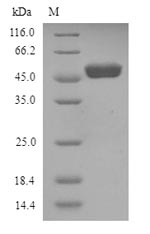The synthesis of this Recombinant Human WT1 protein depends on the utilization of recombinant DNA technology to a large degree. DNA sequences that encoded the WT1 protein could be inserted into a vector and introduced into an expression host, Yeast, where it could be easily expressed in and purified from. The expression of this WT1 protein was at 1-449aa. N-terminal 6xHis tag was fused with this protein. The purity is 90%+ determined by SDS-PAGE.
WT1 is gene encoding a protein named wilms tumor protein (WT1) or WT33 in human. The protein encoded by this gene regulates the expression of multiple genes through binding of the Cys2-His2 zinc-finger domain to promoter sites. It is involved in multiple biological processes, including adrenal cortex formation, adrenal gland development, epithelial cell differentiation, positive regulation of apoptotic process and DNA methylation, negative regulation of cell growth and cell population proliferation.






